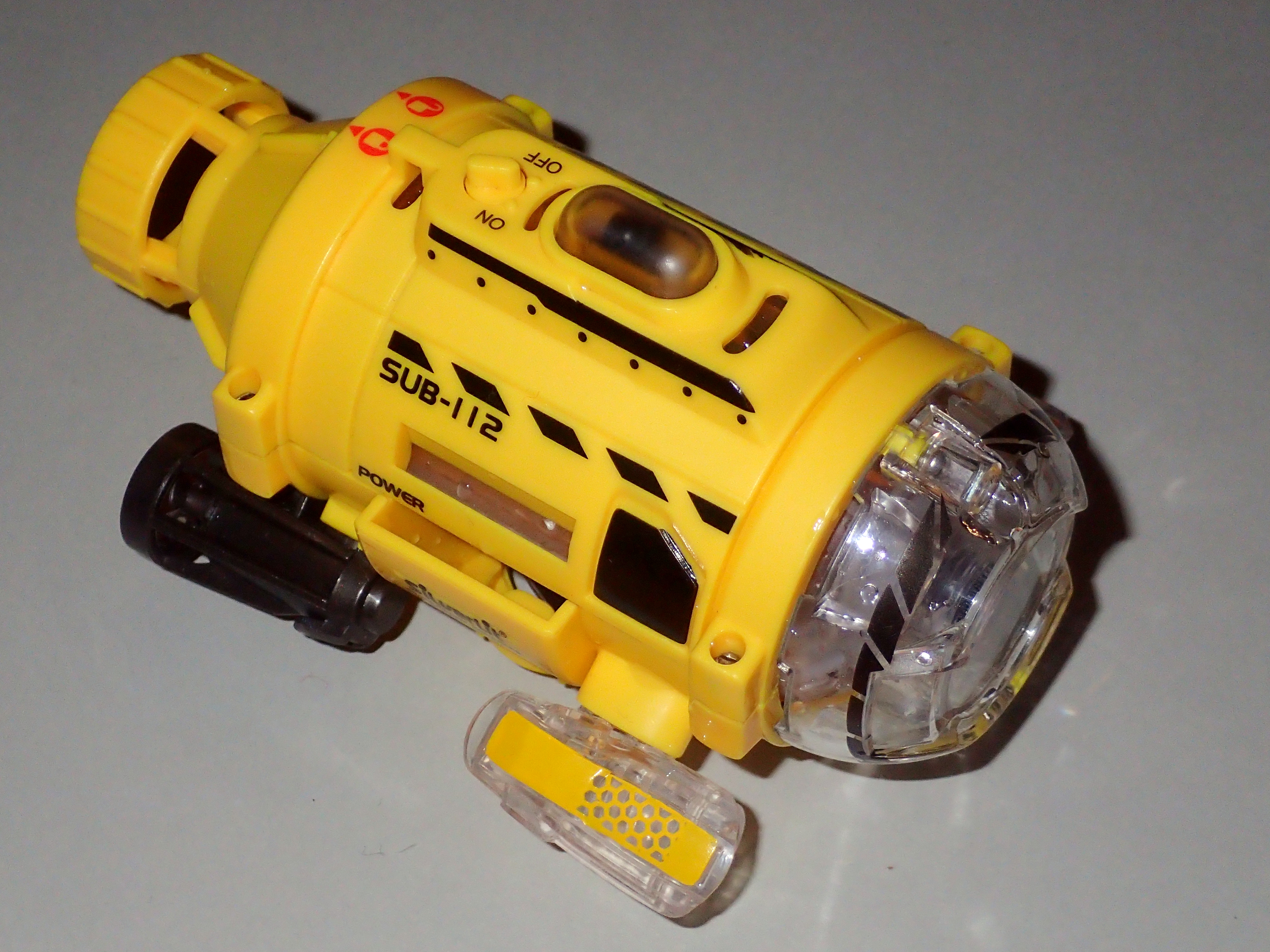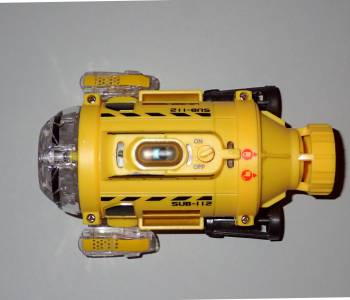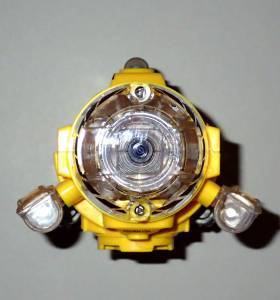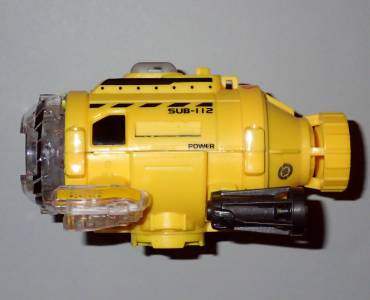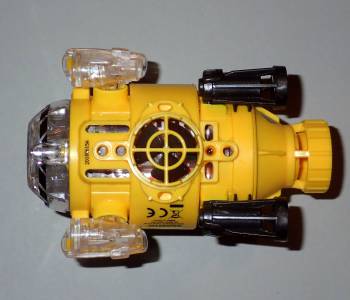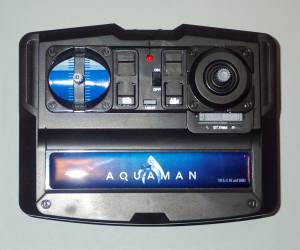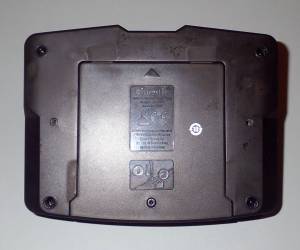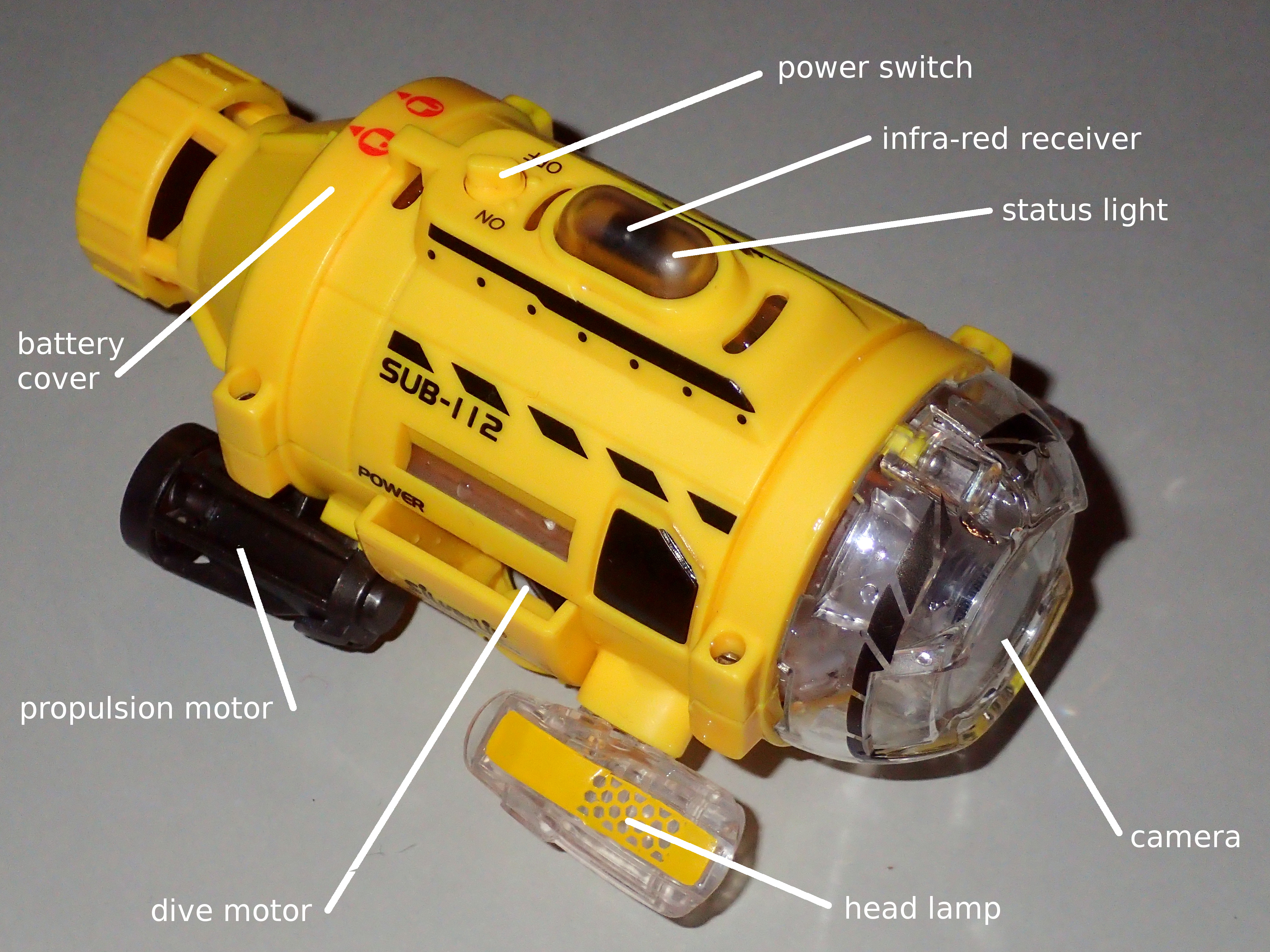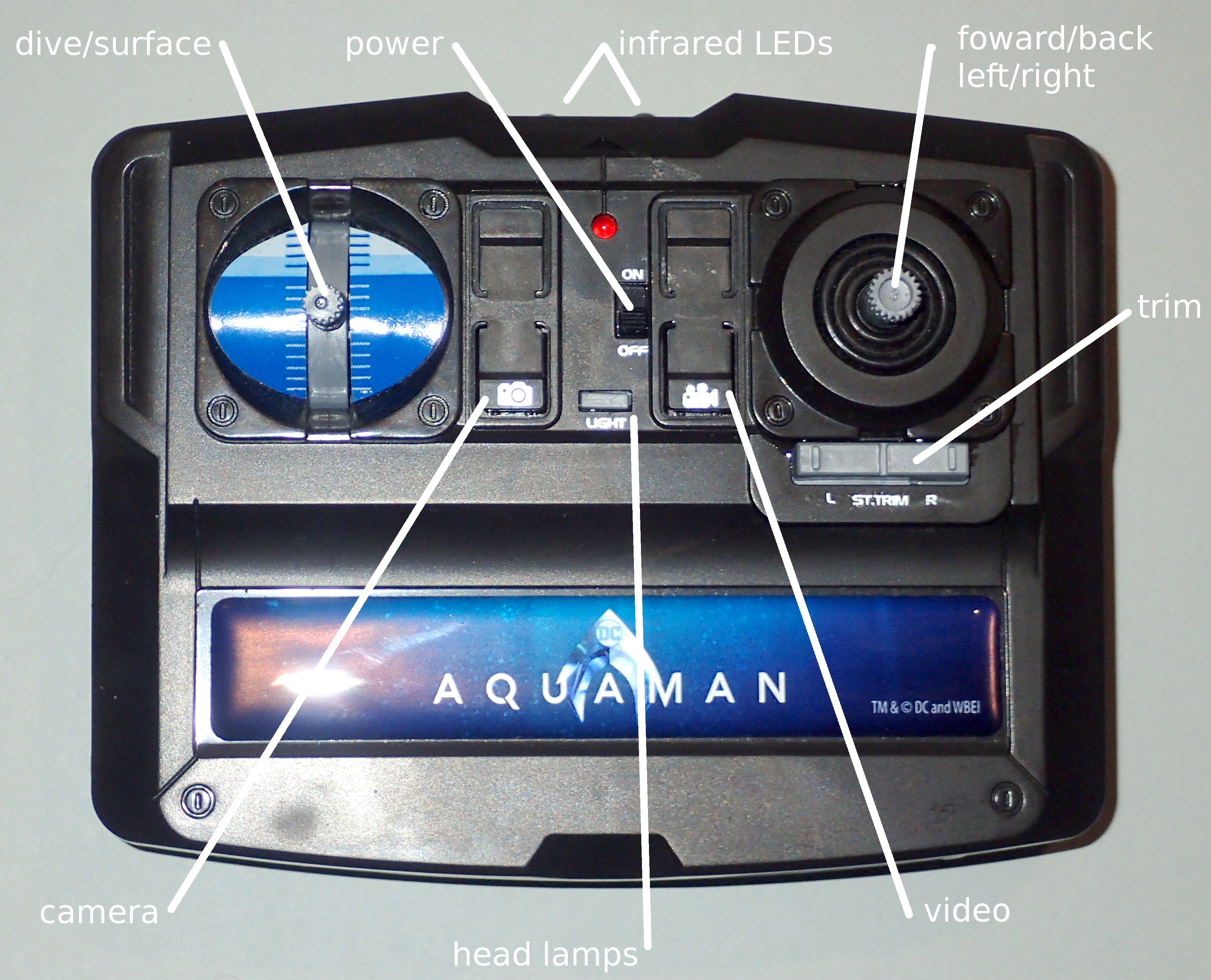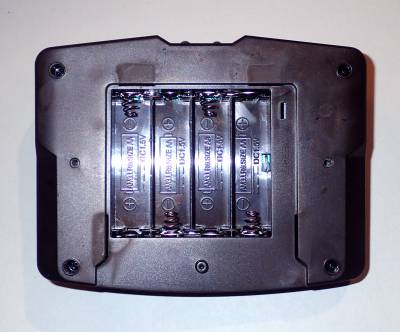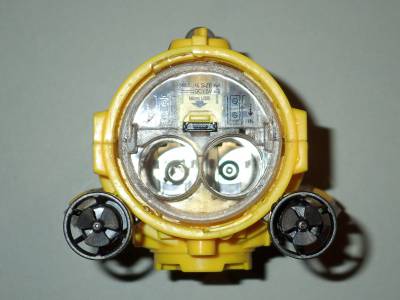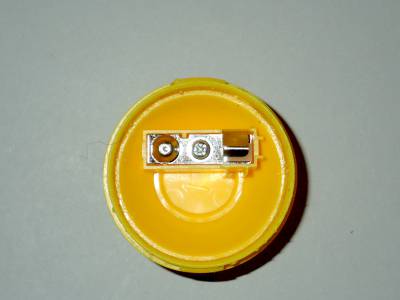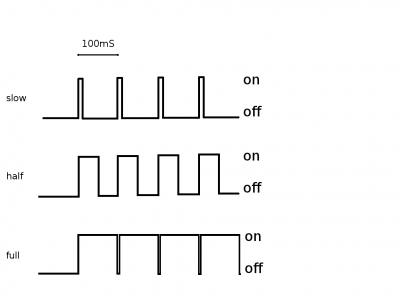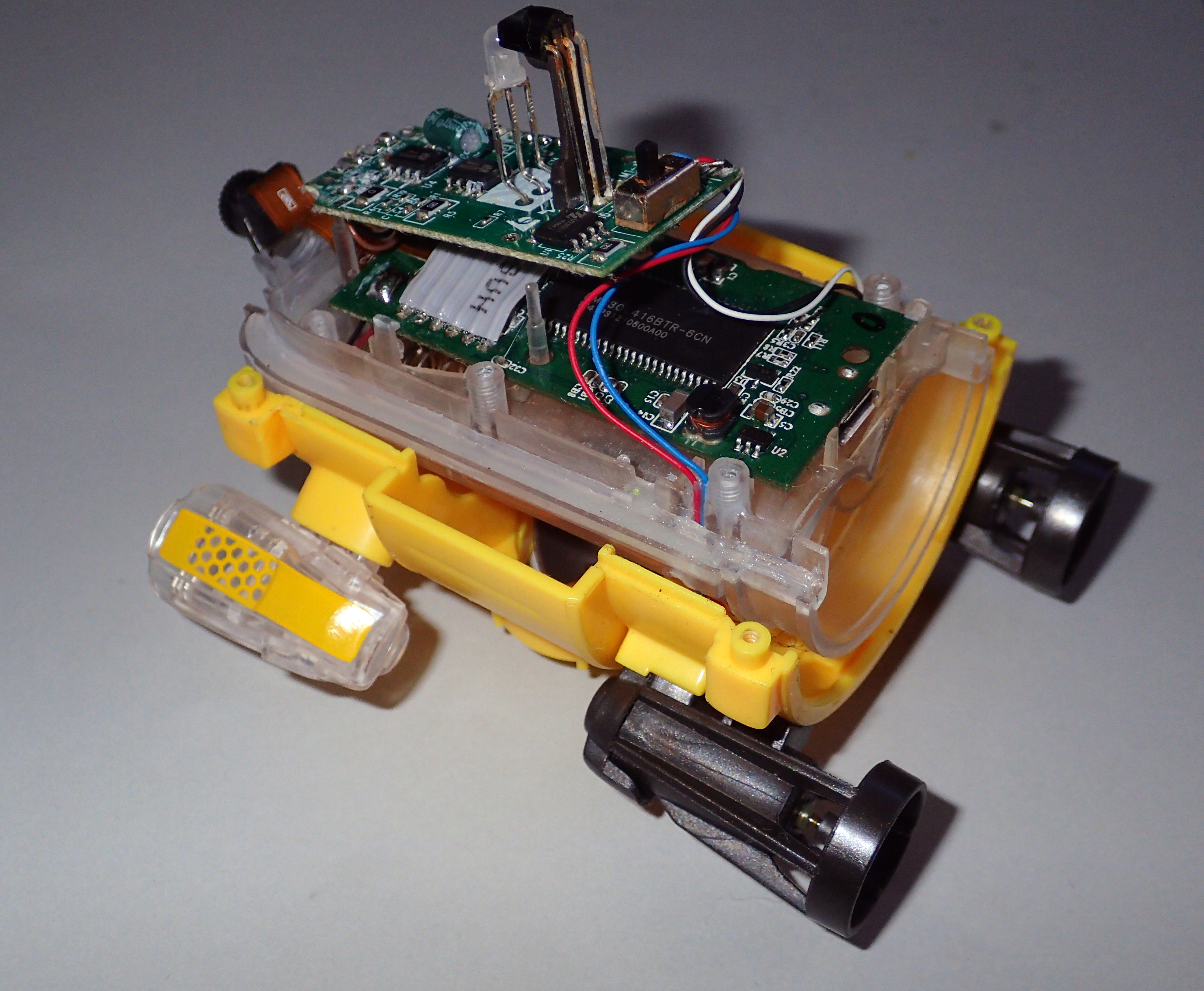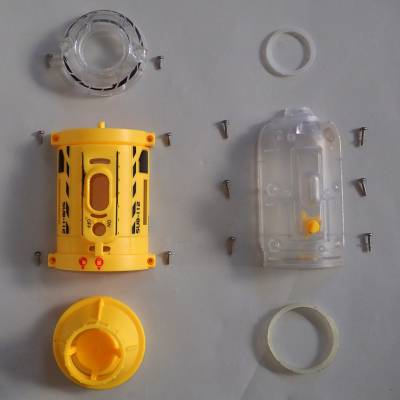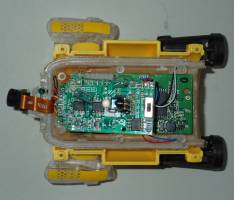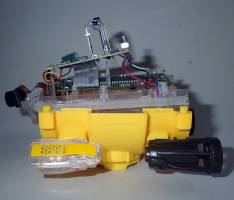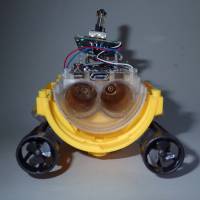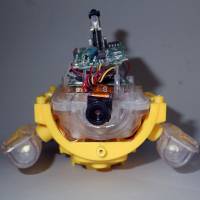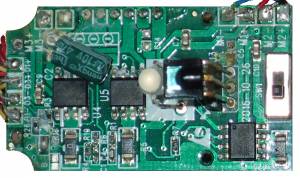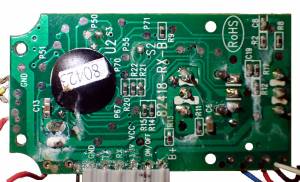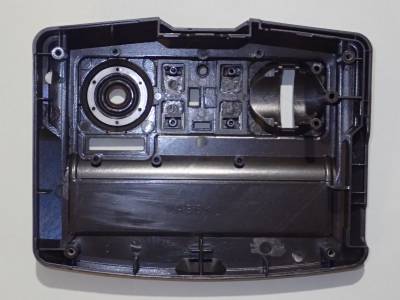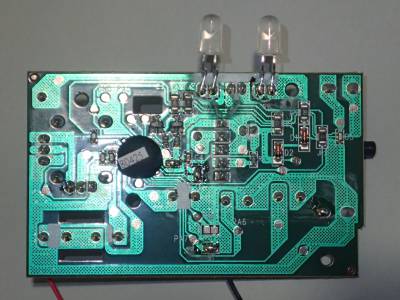Published 20 Oct 2019
Silverlit Spy Cam Aqua
Overview
The Silverlit Spy Cam Aqua (Sub-112) is a small toy submarine with infrared remote control and onboard video camera.
| Specifications: | |
| Dimensions | 11.5 (L) x 7.5 (D) x 6.5 (H) cm |
| Weight (no batteries) | 91 g |
| RC Range on Surface | Approx. 5 m |
| RC range Submerged | Approx. 2 m |
| Top Speed | Approx. 0.1M/s |
| Memory | 256MB |
| Photo Recording | 1280 x 960 pixel, jpg |
| Number of Photos | Approx. 1000 |
| Video Recording | VGA 640×480 pixel, avi |
| Video Length | Approx. 6:45 mins (235MB) |
| Battery, Submarine | 2 x AA Alkaline batteries |
| Power | 3V, 3W |
| Duration | Approx. 30 mins |
| Battery, Remote Control | 4 x AA batteries |
| Power | 6V, 0.6W |
| Measured performance | |
| Video Length | Up to 10 minutes |
| Minimum focus | 30 mm |
| Maximum focus | 100 mm |
| RC Range on Surface | > 8.5 m |
| RC range Submerged | ? m |
| Battery, Submarine | 2 x AA Nickel-Metal Hydride, 2450mAh |
| Duration | > 30 mins with 3 motors and headlamps on |
| Battery, Remote Control | 4 x AA batteries |
There are three accessories:
- a cover for the dive propeller to help prevent it being fouled
- a fish feeder that attaches to the front to attract subjects for photography
- 4 ballast weights in the form of screws that can be inserted underneath to adjust buoyancy.
Also sold as “EXost” “X AquaSpy”, brand “Tooarts”. There also appears to be a similar (later?) model labeled “Submarine 3046”, “Cam Project-T”, that has a steerable rudder and different remote controller.
Commercial material
Hardware Description
The submarine contains 3 motors - left and right side propulsion motors, and a dive/surface motor. There is a forward-facing camera and two white LED illumination lamps. On the top there is a power switch, red/green status light, and an infrared receiver. Both electronics and motors are powered by a single pair of 1.5V AA cells.
The submarine has an outer plastic hull, and another inner waterproof hull that contains the electronics and batteries.
The camera has a fixed focal distance, and things are reasonably in focus over a range of 30 to 100mm from the front of the submarine. The optimum seems to be about 70mm.
Remote Control
The remote runs off 4 x 1.5V AA cells. It has 7 controls that signal the submarine using 2 infrared LEDs :
- Power on/off slider switch (doesn't turn submarine on/off)
- Dive/surface linear slider
- Left/Right Up/Down joystick
- Left and right trim
- Single photo shot button (1280 x 960 pixels)
- Video record button (640 x 480 pixels, 25 frames/sec)
- Headlamp on/off push button
The remote communicates using bursts of a 38kHz carrier, infrared, signal. The signal is encoded using pulse length modulation (PWM).
Batteries
In freshwater, using Alkaline batteries, the submarine floats with just the status light dome above water level, in saltwater it floats slightly higher. Carbon Zinc, Alkaline, Lithium and rechargeable nickel-metal-hydride batteries all weigh different amounts. Rechargeable nickel-metal-hydride weigh the most, and the submarine just sinks to the bottom as they are too heavy.
| AA batteries | ||
| Type | Brand | Weight |
| Carbon/Zinc | Harvey Norman | 14.25 g |
| Lithium | Energizer | 14.75 g |
| Alkaline | Panasonic | 23 g |
| Alkaline | Philips | 23 g |
| Alkaline | Duracell MN1500 | 23 g |
| Alkaline | Energizer Advanced | 23 g |
| Nickel-Metal Hydride | Power Sonic NH-1500AAL | 23 g |
| Nickel-Metal Hydride | Fujicell | 25 g |
| Nickel-Metal Hydride | Energizer NH-15-2300 | 28 g |
| Nickel-Metal Hydride | Energizer NH-15-2450 | 30 g |
| Nickel-Metal Hydride | Energizer NH-15-2650 | 30 g |
If using rechargeable nickel-metal-hydride batteries, a plastic drinking straw (cut in half and all ends sealed) gives about the right buoyancy compensation - attach half on either side and move them forward/aft to adjust the trim.
Operation
The two propulsion motors are driven together to give forward or reverse motion. Varying the relative speed of those left and right side motors is used to turn the craft. There is also a trim adjustment to account for differences in the left/right side propulsion. The joystick allows for variable control, so can drive the submarine at variable speeds. The propulsion motors are driven at variable speed using pulse length modulation - ie they are turned on and run a full speed for a short period, then turned off for a short period, the ratio of on to off determines the average speed. Speed control appears to go from a 20% to 100% duty cycle.
The dive/surface operations rely on the submarine being about neutral buoyancy. Water is propelled upwards through side vents to force the submarine below water, and the motor is reversed to jet water downwards to make it surface again.
If while recording video the submarine runs out of memory space, it will stop recording and flash the red status light. If you happen to switch off the submarine while it is recording you will likely end up with a corrupted file and possibly corrupted FAT filing system on the submarine's inbuilt memory card.
The submarine has a safety timeout, and if there has been no change in the signals received after one minute, it turns off the propulsion and dive motors. It continues to record, and the headlamps stay on if they were already on. Any command, including lights on/off will revive it.
The buoyancy needs to be trimmed so that it floats to the surface upon loss of communication, or power.
When using the dive propeller to surface, the two side propellers turn on as well.
Example Trips
Tear down
| Submarine |
|---|
The outer plastic hull is secured by six screws, two holding the front and four holding the top and bottom halves together. The screw heads need a triangle 2.0 screw driver blade. The inner plastic hull is held together by six philips head screws and silicon sealant rings on both ends. The battery cover seals against the rear silicon ring.
Inside the inner hull there are two double-sided circuit boards. The top, smaller, one (“82418-RX-B”) contains the on/off switch, infrared receiver and bi-coloured status led. The illumination LEDs and three motors connect directly to this board. There is a 6-way ribbon cable connecting it to the larger logic board underneath.
The camera, USB socket and battery connect directly to the second board which contains a large IC on the top (PMS306416B 64Mbit, Synchronous Dynamic RAM) and another large chip on the underside.
The 82418-RX-B board has an epoxy covered controller chip (labelled 80423) on the underside, and on top there are three 8-pin chips (MX608E motor controllers) and a 47uF, 10V capacitor.
| Remote Control |
|---|
The remote control is held together by four philips-head screws. The headlight on/off button and battery cover spring release are not fixed down and so may come loose after the cover has been removed.
The controller is a single-sided PCB with the components mounted on the underside. It contains a single (20pin?) IC (labelled 80425) covered in resin, two transistors, a few passive components, plus the two infrared LEDs.
Limitations and Problems
Because the communication between the submarine and remote control is via infrared, the remote needs to be pointed towards the submarine, and the range is severely reduced in bright sunlight.
The remote control is not waterproof or even water-resistant, so care must be taken with the remote, eg careful not to transfer water after handling a wet submarine.
The LEDs don't provide enough illumination for photography in total darkness.
If operating in a natural environment (eg a seaside tidal rock pool), the propellers are liable to be fouled by drawn in seaweed etc. - so the submarine may have to be manually retrieved, particularly awkward if the dive propeller fouls on seaweed attached to the bottom of the pool, and gets stuck while submerged.
No sound recording, video lacks something without a bit of sound.
References and Additional Resources
Silverlit
Silverlit remote control
- https://www.nxp.com/docs/en/application-note/AN3053.pdf Application notes for an infrared controller chip
Other Submarine/ROV Resources
- http://www.camne.com.ar/submarinos/submarinoggda/submarinoggda.htm?i=1 GGDA Explorer Submarine
- http://www.camne.com.ar/submarinos/submarinoggda/ggdaplanosfotos.pdf GGDA Explorer Submarine
- http://www.subcommittee.com/ Radio Control Submarine modeling
- http://subcommittee.com/forum/forum.php Radio Control Submarine forum
- http://rc-sub.com/home/index.php Model submarines
- https://forum.rc-sub.com/ Nautilus Drydocks forum
- http://www3.sympatico.ca/ted.scrivens/ Radio Controlled Model Submarines & Submersible Video Platforms
- https://www.rovworld.com/forums.html ROVworld Subsea Information: Forums
If any referenced page no longer exists, try looking for its URL on http://archive.org.
